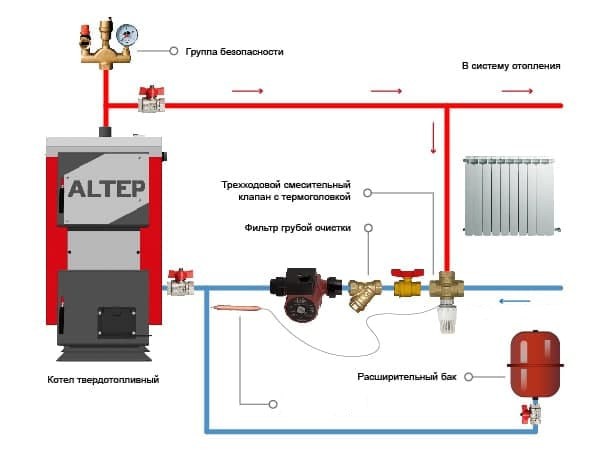Solid fuel boiler layout
Boiler piping is the integration of the heating system, all components, circuits and elements into a single complex in accordance with the rules and regulations for equipment operation. This allows for safe and efficient boiler operation.
How to make a boiler strapping correctly
To determine how to properly install the boiler piping, experts advise that you familiarize yourself with the possible methods in advance. They may differ depending on the type of boiler and the flow arrangement.
The heating scheme can be open or closed. As for the circulation of the energy carrier, it is divided into gravitational and forced.
The open version involves the use of an expansion tank without a lid. Its main tasks are as follows:
- the ability to add water to compensate for evaporated liquid;
- the ability to adjust the amount of energy in case of overheating;
- the ability to remove air plugs when the tank is installed at a slope relative to the heat exchanger.
In the closed version, there is no connection to the atmosphere and the circuit is pressurized. For this design, overheating is very dangerous, as it can damage the pipeline or devices. To protect the circuit from a possible hydraulic shock, the system has an expansion tank equipped with a membrane.
Before the heating boiler is strapped, it is schematically depicted:
- heat supply source (additionally, its capacity and the heat carrier used are indicated);
- auxiliary equipment;
- heating elements.
The first and most important point is to choose a boiler. When buying equipment, consider:
- external volume;
- the area of the room and the size of the doors and windows installed in it;
- wall insulation and their specific thermal conductivity;
- the number of days on which the heating is likely to be used;
- air temperature outside the room during the heating season.
Based on these data, a thermal engineering calculation is performed. The service life and efficiency of the system and the prevention of overheating depend on how well the heating boiler piping scheme is designed.
Proper strapping of a solid fuel boiler
The wiring diagram of a solid fuel boiler is as follows.

When choosing the method of piping the boiler, it is important to take into account the presence of a heat accumulator. In cases where the use of a buffer tank is not provided for, the heating system includes large and small circuits of the heating system. The installation of a small circuit is carried out according to the following algorithm:
- A safety group is installed after the solid fuel boiler.
- A tee is mounted at a distance of approximately 1.5 meters. The supply and return pipes in the system are connected by a pipe.
- To monitor and, if necessary, adjust the degree of circulation of the coolant, a wedge valve is mounted on the connecting pipe.
- A three-way mixing valve is placed on the back. The place of its installation is the pipe that connects the return to the supply.
This scheme works as follows:
- When the solid fuel boiler is started up, the heat transfer medium moves in a small circle. To prevent cold water from entering the heat exchanger, a travel valve is used. If a temperature drop is allowed, condensation will appear in the boiler, which can damage the heat exchanger.
- After the coolant has reached a temperature of 60 degrees, the three-way valve opens and the large circle comes into operation.
- In this case, the small circle acts as a mixing unit, protecting the coolant from boiling and correcting the temperature difference between the supply and return flow.
Tying up a solid fuel boiler with a heat storage device
An approximate scheme of the piping of a solid fuel boiler with a heat accumulator is as follows.

A heat accumulator, or buffer tank, helps:
- save up to 50% on fuel;
- protect the boiler from overheating in the event of an emergency;
- reduces the number of fuel loads, making the use of a solid fuel boiler more convenient;
- stabilize the boiler operation in one mode;
- accumulate heat during the off-season;
- ensure the system's controllability.
When choosing a method of strapping the boiler and buffer tank, it is important to take into account such indicators as the volume of the furnace, equipment capacity, type of fuel used, and other parameters.
The simplest and most affordable scheme for piping a solid fuel boiler with a buffer tank can be considered the following:
- boiler;
- pipeline;
- heat accumulator;
- circulation pump.
When strapping a solid fuel boiler with a buffer tank, some nuances must be taken into account:
- When installing the heat storage device, do not use welding connections;
- installation is carried out using couplings equipped with a flange or thread;
- the pipeline must be equipped with shut-off valves;
- temperature sensors must be installed on all circuits;
- a drainage valve must be present in the system;
- coarse filters must be present at all inlets;
- It is important to have an automatic air vent;
- to avoid freezing of the coolant in winter, its installation is carried out exclusively in a warm room;
- It is important to have free access to all circuits.
The temperature of the coolant in such a system can be controlled with the help of:
- three-way mixing valve;
- the connected circulation pump.
Each option has its advantages and disadvantages, so it is recommended to consider each system individually.